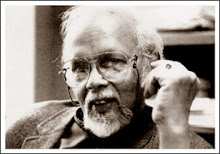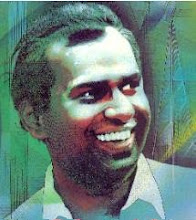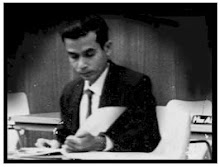Source: Island
Date: 23/10/2002
At the National Drama Awards 2002 an artiste often short-listed for his abrasive arrogance in theatre relations, bowed and knelt before Iranganie Serasinghe while offering her the latest issue of "Abhinaya" (a Cultural Dept. drama mag) servicing tributes to two eminent personalities of the theatre - Bandula Jayawardena and Iranganie Serasinghe. The blaze-up coming so late made people wonder about many things. Very few knew and may care to know that there a student-actor paid homage to a teacher-director; that the English theatre’s memo pad should have taken us back to Iranganie’s first essay as theatre director - and the only long play she did that way - Gamini (Kuru) Gunawardena’s "Rama and Sita" in which he played Vibishana. In drama and film-often player among all players, Iranganie’s image has got so smothered that these overdue yet isolated excavations of a luminous career by culture journals like Abhinaya (edited by the said student-actor himself) could hardly privilege any image that could compete with the commercials that television presents day after day. Of course Iranganie - not to mention Tony Ranasingha - does dispose of their creamy crackers better than most known ‘non-actor-actors’ cart-loading and trolley-loading us with veritable consumer market gross.
Abhinaya’s editor takes up the image gloss and stereotype hyping suffered not only by the redoubtable M. Serasingha but even by the Wayside Theatre’s Other Actors. I do not want to dwell long on these sad discourses. The seductions of advertising power-play are not my willing subject here. Yet the cap I throw would fall unconscionably on the choice CUP seen on national television’s News desk. What those like the writer wonders is why the hell the relevant announcer doesn’t take a sip from that cup so near at hand. What I mean is even if these announcements do not make us thirsty for local news one could well be thirsty reading it. I am not sure whether I haven’t seen these people wiping beads of perspiration from their news-weighty foreheads, - national newscasts do inspire the innocent so!
The now proverbial cup or mug ("we are but clay and some people make mugs of us" is the relevant quote) came up for honourable mention at the Horana Campus the other day when a far-seeing Student Body (students, could do these things, you know) upstaged under their own sway a series of culture exposures - including a week’s review of film, popular classics and semi-classics - for the edification of the Freshers etc. On the second day in a series of encounters Deepthi Gunaratne - posting a one-man discourse from the post-modernist X group - referred to this very Cup or Mug. It was one concrete token of the commercial ‘de-massification’ of the media. Of course the erosive commercial interventions came sometime ago, but the point holds. Deepthi carved out a very simple clear-cut "message" starting with marshal McLuhan’s "the medium is the message" - old hat indeed donned however with sharp relevance.
The participation of Tudor Wirasingha, Marxist - honest and earnest - made this difficult engagement thick but pleasant. Response was hardly lacking, but I’d have liked a wider span for Mr. Gunaratne. The programme being packed with Asoka Handagama on the wings and a film to follow these unfinished things had to stop. At least one sadist (me) would have enjoyed some cross-cuts and zooms to Dharmasena Pathiraja, ideologist-aesthete formerly of the Horana Campus, who I felt was missed at these bracing intellectual jaws. Why Pathiraja has been missed out is a long story on the sadder side of the Campus’ powerplay in which unfortunately the students also played their role.
As for the demystifications that went on last week they began early on the Campus’ fresh culture conveyor belt thoughtfully arranged by the students. Quite before Deepthi and Tudor problematized ‘mediology’ for these media hopefuls Gamini Haththotuwegama took our theatre ‘history’ by the scruff of its neck problematizing the very concept of drama and the constructions of the Sinhala Theatre. In his performed critique scissoring through the decades to the present day, Haththotuwegama gave the media a deserved spanking on its unconscionable manipulatory a... He tore apart the Romantiquing constructions engineered by the media for so-called Valentine Day.
This, Haththotowegama foregrounded via Dhananjaya Karunaratne’s brilliant (short) play called "Valentine Enakang" ("Till Valentine Comes") which hugely spoofed this hocus-pocus while seriously taking to book youthful love’s own Romantique. Certainly in this little play two friends from their free and open childhood days, now Lovers Two, run into trouble - the woman being about a foot taller than the man. And that is the trouble, the man just can’t take it, it blows up on the birthday, ending in his running away breaking the bond for ever. It’s a funny even hilarious, witty "little" play (the girls birthday gift surprise is an 8’-10’ high-heeled pair of boots!) very cleverly worded and succinctly plotted drama, poignant to the core. The other day in a sweeping thrust Deepthi G made the point that he does not see/meet any civilized being on the road. Which reminds me there was just one of these ‘uncivil’ words that Dhananjaya K sprang on us straight from sexist slang. You have to put that up however against the unmitigated load of male-oriented sexist jokes and jabs at female kind delivered in recent play upon play.
Yes these Sinhala plays were allegedly taking part in the 1990s to 2000 (alleged) explosion of realism. Most of these sexually liberated plays stereotype a ‘bedroomish’ set. The drama begins ... somebody knocks on the door / walks or crashes into the bedroom in this economical dramatic household. Economical my a...! Realism has not only become violently sordid (for it is violent too!) but one hell of a litter bug. Yes you have to have a smoke and cigarettes must be lit plain and ashes dropped to perfection on the stage floor. If there happens to be a clothes-line too inside, you must have all the clothes from the laundry basket. A room strewn with scraps of paper has to be the street garbage carrier’s bane. No, you couldn’t say there is no daring, there is a violent daring that would have made the Apey Kattiya of the 60s look sissy. There could be daring when a Buddhist priest (seem-up) hides in a prostitute’s room but the "maximum kill" peters out only in a little bit of humanising pity. Man and woman are boldly confronted in these throw-outs and that’s a gain - the sexual confrontations are bold but they are hardly investigatory or exploratory. Most often they are superficially sensationally vulgarized and brutalized (in humour so on). The possibly liberating influence that post-modernists (like the X Group e.g.) might at best release, touches the theatre at the margins or not at all. Sadly the established formal theatre, while making exceptional inroads into realism (which I’ll come back to - I have to hustle through here) hardly challenges the ideology and ‘aesthetique’ of realism themselves nor finally the power culture mystique, because as the alternate theorists maintain it does NOT really fundamentally challenge itself but goes on escaping or retreating into itself.
Paradoxically maybe the Other Theatre seems to be ready to do it or is already attempting it. In one newspaper blast Haththotuwegama, who (most folks do not know) strides both formal and non-formal ways - said: "Nowadays any damned rot is taken for Street Drama." Alongside this you have to place (more than) one scything sweep at the formal theatre (Peradeniya, Horana, Colombo, and Rajarata Campuses): "Any bloody garbage or shit presented on the formal stage is automatically taken to be a play."
There is a long and deep take here. The very idea of a play, the very concept of a text is thrown at the stake. The latest ‘Abhinaya’ issue problematizes the text in an editorial essay. Those who have had the critical foresight (and good fortune) to see the latest creative work of the Other Theatre ("Wayside," "Open," "Street," "Non-Formal" - whatever label you might use) and study it without the pre-conceptions (now at stake) brought over from the established formal theatre, may have to concede a lot also on the practical "achieved" side, vis-a-vis the shake-up of the concepts of text, play and dramatic construction in toto. With productions like "Marawa Mehewara" (not to mention ‘Ammata’) ‘The Wayside and Open Theatre’ in their recent experiments have possibly stolen more than a couple of marches on the formal theatre.
Their "Marawa Mehewara" is a "complete" transcreation in dramatic terms of a 5-6-line prose "parable" ("Mr K" I think) offered by Brecht. It is prioritized here not since this piece uses, very unusually, all human body (in a very body conscious play) for set, props, furniture - all (door, chair, mirrorstand, bathtub and bed) but since it upturns our (fixed) ideas of the text (they are very fixed in the contemporary theatre) problematizing dramatic structure and aesthetique - speech, silence, dialogue not to mention action and character (certainly). The play pursues and challenges the power mystique, the culture and violence mystique in totally new and different ways from what the formal theatre invariably does despite the new personalized psychology brought into it and achievements thereof.
An Unwelcome Visitor (one of two characters in the play) knocks on the door of a presumably innocent citizen, barges in and goes on imposing on the latter demanding this and that form of hospitality (not in any way detailed by Brecht) and ultimately goes to sleep getting the man to read him an (‘animal’) story. In the Brecht parable there is none of this - the man utters not a single word. Here too there’s no dialogue but a "non-dialogued dialogue" as the Man reads the story and the Visitor responds. The read tale is a double-twisted construction of the fox and the girl tale - here two girls - one blissfully triumphing over the Fox, the other unwittingly about to fall a victim to him. The visitor goes on all fours as he identifies himself with the Fox. The story of the sour grapes is woven into this complex text and structure. The play retains the visitor-dying-at-the-end part but how he dies is puzzled up in the drama. Now this is offered as Other Theatre, yes even street theatre!
No wonder the Other Theatre is sabre-rattling thro’ the aesthetics of the formal established theatre! I think we need another day and another column to bite across the range of issues raised because there is lot that’s taking place. The English Theatre is also reacting to "sexual liberation" in its own way. There is much that it has to live down and that concerns the schools’ Shakespeare mainly. Now Shakespeare is in Love, not always with competitions!
Who is in love with competitions? In the Sinhala Theatre even those who hack it mercilessly go to it head unbowed maybe till the results are announced and then ... It would be grossly inadequate to foul the image of the Sinhala Theatre, it still offers the priorities of vigour and continuity and creativity. Some of the most deservedly generous tributes to the contemporary theatre have come from Haththotuwegama himself.
Dhananjaya Karunaratne’s short play "Chandrawathie Samaga Rathriyak" ("A Night with Chandrawathie") was on his short list of praise for rare explorations into sexual relationships and Piyal Kariyawasam’s "Mata Erehiwa Mama" ("Me Against Me") for its brilliantly adroit channeling of a political text through the memory and personal career of a government official, the realistic complexities it fuses with ease bringing office and bedroom together and the broadened creative span it offers thro’ the playing of Saumya Liyanage in the whole technique of realistic acting.
Such images collage into these studies. At the very beginning of the column I was pinned by the need and difficulty of sorting out contradictory images, which continue to haunt us some stupidly benign, some tragically inevitable, some I do not know.... For as I end today’s critical munch. I see one of the most exciting ‘creativists’ of our dominant theatre coming for a brief flirtation with the Lionel Wendt, offering a refreshing cup for what he called the privileged few who he felt could understand their new theatre.
He called this elitist exercise "Off-Theatre"! It ended - soon fortunately with DK’s creative impulses unimpaired. Strange as it may seem I find a nasty slippage in my sentences above, or sippage you might say, for the Cup (or Mug) has come in again! There are all sorts of de-massification going on ("off-theatre" at the Lionel Wendt threatened to be so). All dominant power-play you could make out is connected umbilically to capital and Commerce; you do not need to be a bloody Marxist or X Group to get that. We may (all) be clay but are we always willing to be made Mugs of?




































No comments:
Post a Comment